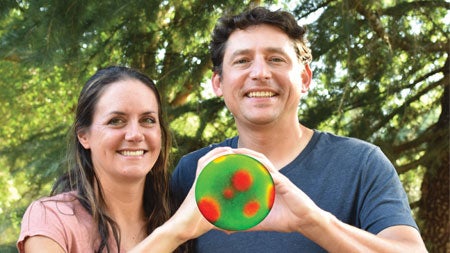
(From left) Kandice Levental, PhD, and Ilya Levental, PhD
The collaborative team of Ilya Levental, PhD, and Kandice Levental, PhD, professors in the Department of Molecular Physiology and Biological Physics, has published new research in the journal Cell that discovers new layers of organizations and functions in lipid membranes, with important implications for human health and disease.
For each of the trillions of cells in our body, the crucial job of keeping the inside in and outside out is performed by extremely thin membranes. These membranes are made of fats called lipids, many of which we consume in our diets. Despite being extremely thin, cell membranes are made of two distinct layers (i.e. they are bilayers) – often called leaflets. While the two leaflets of man-made membranes are almost always the same, living membranes are almost always asymmetric, in that they have very different lipids in the two leaflets. Our cells use a tremendous amount of energy to maintain this arrangement, which is crucial for cell life and communication.
While it has been known for 50 years that the two cell membrane leaflets are compositionally different, it has always been assumed they at least had the same number of lipids. The assumption is obvious: imagine a sandwich where one piece of bread is much bigger than the other—you’d get mayo on your face with every bite! But the Levental lab has discovered that this assumption is – in their own words – “generally invalid and for mammalian membranes, dramatically incorrect.”
It turns out that two aspects allow very different lipid numbers in our membranes: (1) the leaflets can stretch and squeeze to fit together, more like spongy challah than a dense German rye and (2) cholesterol, the most abundant lipid component of our membranes, can act as a buffer to maintain robust barriers in spite of chemical and physical imbalances.
Not only does this finding contradict a decades-old assumption that underlies most current understanding of cell membranes, but it also makes many important predictions about how such membranes works and what their asymmetry might be for. The group explored several of these, finding that membrane asymmetry is a critical controller of cholesterol deposition into fat storage. Such depots – called fat droplets – are crucial for health and disease, connecting fundamental cell biophysics to clinical relevance.
Filed Under: Research
